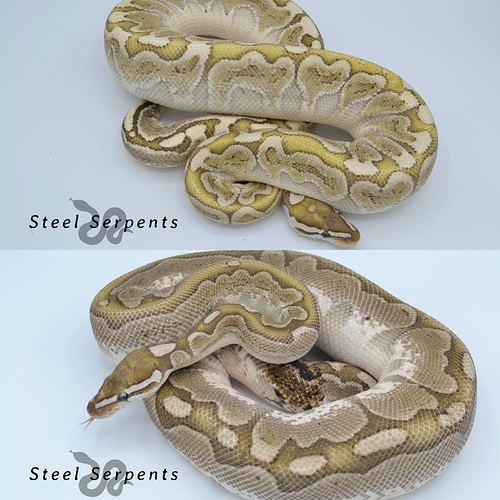She’s growing up nicely. One of the best ones I’ve produced. I wonder if its the het Clown influence making that orange color really pop!
As I read through this all I can think of is when we start talking about how clown might be a co-dom with weak single gene influence but the super is awesome.
Lol your snake is absolutely beautiful 
I don’t think it’s het influence I just think it’s a case of a stellar pairing. Super nice!!!
I know, just the whole pied thing is a really fun thing to read/research; at least for me 
I’ve been looking around and I’m going to check around the marketplace to see if there are any obvious differences between non het clown and het clown because I’ve heard this thought many times.
My het clown banana I used to have was very dull in colour so the het did nothing to him to brighten at all, where as my het pied banana I had was bright and my normal banana I still have is bright. So my het clown personally was really dull, I’ve seen other het clowns that have done nothing at all also. So maybe just some genes it appears to brighten, or just hit or miss depending on parents etc?..
Just bear in mind clown is a proven recessive gene. You get variation is all morph this does not necessarily equate to het influence.
Do you have a link to somewhere I can read about this?
Correct my fault meant recessive lol
Regarding “het influence”, I’ve seen numerous big breeders state they see differences in the heterozygous versions of various recessive mutations. Clown, lavender albinos, and of course pied are notable ones:
These differences could be attributed to the polygenic makeup of the bloodline but there seems to be more to it than that. With pied in particular there are enough visual characteristics commonly identified in the hets to certainly suggest so. It’s possible other recessive mutations cause similar disruptions in heterozygous form but with less obvious identifiable visual characteristics.
This goes against the very definition of a recessive trait. If these het influences were true then by scientific definition they would be incomplete dominant genes.
It’s not they would be incomplete dominant traits then not recessive.
And those are likely the top 3 recessives. Would we notice other ones if they were as popular?
Then it’s possible some of the “recessive” morphs are actually dominant. I personally believe pied and clown are dominant.
It’s not out of the realm of possibility that one of them may actually be a incomplete dominant gene. But not all of them my point here is if a gene is recessive there is zero visual indicator in the het form. That’s what makes them recessive lol
Whether or not visually identifiable characteristics are present in heterozygous form is what solely differentiates recessive from dominant mutations. It’s possible that certain visual characteristics could be extremely subtle and potentially even move from the realm of “identifiable” to “not-identifiable” from natural polygenic variation and other factors.
When you look at pieds in particular for example you’ll find numerous large scale breeders claiming they can pick them out with great consistency. This goes against the idea that some of these well established mutations are completely “figured out” and might even be improperly categorized.
The original poster saying he thinks his very nice pied may be influenced by being heterozygous clown isn’t so far fetched IMO.
The definition of a recessive trait is expressed only when the determining gene is in the homozygous condition. We can’t just change the definition of a word in order to match our personal opinions.
I agree completely. After looking at pieds and het clown pieds on the marketplace there is a noticeable difference. @staff, I think this should be moved to another thread, this is getting off-topic from the original post.
Which is exactly why when there is a noticeable difference in the heterozygous form (pied & clown) it is actually inc-dom regardless of what is previously thought about the morph.
Then it shouldn’t be called het influence that’s inaccurate. Right now the general consensus is the hobby is all these traits are recessive.
Het refers to one copy of a gene, recessive or dominant. Black pastel could be considered het influence since it is how the heterozygous form of black pastel changes the patterns and colors. The hobby might consider them recessive but that doesn’t mean that they actually are. Is the definition of recessive:
Only expressed in homozygous form
or
Only has an obvious expression in homozygous form
If it’s the first (which it is) then that would make pied & clown dominant since they have a visual effect (regardless of how small) in the heterozygous form. Compare these to yb. There isn’t a large difference in expression except in the homozygous form but there is a small effect in the heterozygous form. So why should pied and clown be considered recessive when yb is dominant.



